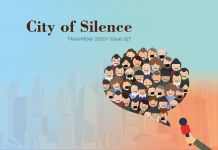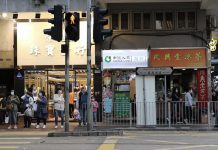What the hype and hysteria over A&F hunks tells us about perceptions of Asian male bodies
By Ian Cheng and Thee Lui
Sweating on the treadmill, pumping iron, counting his crunches – 22-year-old Nicholas Tang Chia-wei works out for two hours every day. Then, almost every week, he takes a photo of the results of his labour and sends it to the headquarters of Abercrombie & Fitch (A&F) in the United States. Tang works as a model in the clothing retailer’s recently opened Hong Kong store. He is working his body so that he can satisfy his bosses at A&F that he is ready to bepromoted to the post of “shirtless greeter”.
These are the topless hunks with the toned torsos that A&F hire to stand by the doors of their stores, greet customers and pose for photographs with them.
When A&F’s store opened in August this year, it flew in around 100 male models to meet, greet and ride around Central on an open-top, double-decker bus wearing trademark red beach shorts and big smiles.
The topless models had the Central lunchtime crowd either whooping in approval, laughing or quietly shaking their heads. It was a difficult spectacle to ignore. Others travelled from across the territory to snap and to touch the men. Online too, it was a phenomenon, setting social networking sites like Facebook abuzz with pictures and both positive and negative comments.
Although it was a marketing event to promote a fashion brand, it stirred up heated debate about issues of gender, masculinity and race. In a society where women are the traditional objects of desire, it threw up questions about whether it was acceptable for women to look at men the way men look at women. The fact that the models were mostly foreigners also threw a light on how people perceive Asian male bodies, particularly Chinese, Japanese and Korean men.
In the U.S., A&F has been criticized for the lack of Asian representation among its topless models, but for the opening of its Asian stores, the company has had to include Asian models. Talent scouts scoured Hong Kong for suitable Asian models for the store’s opening here. By the time of the opening in August, they had recruited six Asian models. Among them were 24-year-old Karl Cheung Ka-wai and 22 year-old Eric Ng Ngo-fung.
Standing next to the bigger, taller, broader-chested Caucasian and African-American models, the pair said they felt “inferior”.
“Actually, there’s a huge difference in physiques; in a comparison, we would totally lose out to them,” says Cheung who is 1.8 metres tall, weighs 75 kg and whose chest measures 99 cm. Cheung says there was an obvious difference between the way young women would respond to the western models and to the Asian models. “They would choose to take their photos with the westerners rather than me,” says Cheung. “I was upset in the beginning, but then I understood it is hard for us Asians to be like the [foreign models].”
Randa Leung Ka-tik, a third-year university student, who has had her photo taken with several models at A&F made her preference very clear. “If you could choose to take photos with either three Asian models or one Caucasian model, you would definitely go for the latter, unconditionally.” Leung says this is because she finds Caucasians more appealing and it is rare enough to see them, let alone have physical contact with them.
Leung is not alone in her thinking, as Cheung’s experiences show. Song Geng, an associate professor at the University of Hong Kong who has written about Chinese masculinity, says the preference for white men is rooted in cultural stereotypes and Hong Kong’s colonial history.
He says Hong Kong’s colonial past gave the impression that westerners are more powerful. There was a tendency to look up to everything foreign, including the ideal type of men. Whereas, in the past, the ideal Chinese men were considered synonymous with members of the literati, scholars with wit and artistry, such men would be perceived as feminine by modern standards.
Travis Kong Shiu-ki, a sociology professor at Hong Kong University says there is a hierarchy of so-called “beautiful bodies” in the West that places black bodies at the top as being “super-sexy”, followed by white bodies and, at the bottom,yellow, or Asian bodies. Under this system, Asian males are considered to lack sex appeal or be feminised.
Kong says Hong Kong is a highly westernised society where people have adopted western standards for the ideal male body type. The media tells us that the ideal male should be young and always slim, fit and muscular with six-pack abdominal muscles. “We are marginalizing a lot of bodies,” says Kong, who asks us to rethink whether we should only have one definition of beauty.
However, this remains the yardstick against which A&F’s Asian models are measured and against which they measure themselves. Kong says it is hard to say whether A&F models are demeaning or empowering themselves.
Whatever the case, Karl Cheung, Eric Ng and Nicholas Tang are all proud of their work. “All of a sudden, people queue up and take turns to take photos with you. After that they look so happy. It’s like I’m helping them. I feel happy as well,”says Cheung. Ng goes even further. “Only those whose bodies don’t look good are unwilling to go topless,” he says. “Being here is an endorsement that you are the best. Everyone wants this job.”
Tang certainly does want the job. For starters, at HK$200 an hour, it is far better paid than being a clothed model, whose job is much like that of a regular salesperson and who gets paid HK$40. Secondly, Tang thinks that being a topless A&F model can help him to become famous.
But the response from the general public is mixed. Some are critical of the shirtless models. Michael Lam, a 21-year-old student, does not understand why guys would willingly become “toys” for women and pose for photos with them. “People lose their control over the models,” he says, while Wilson Yau, a 31-year-old I.T.technician, suggests the job is no different from that of being a male escort.
Others, like 25-year-old teacher Jacky Yuen Man-leuk, do not have a problem with women openly admiring half-naked men. However, that does not mean he would consider being an A&F model, even if he could.
For Jonathan Yip Shing-cheong, a third-year university student who works part-time as an A&F model, this reflects a deeply entrenched conservatism about bodily exposure in Hong Kong.
Yip does not need to go shirtless for his job, but he says that when he first told friends about his job offer from A&F, they were worried. Some of them asked him seriously if he would have to be half-naked in public. One of his friends even sent him a message which included various news clippings on the controversy over A&F’s perceived racial discrimination in the U.S. and on how society views A&F models.
When Yip explained he would not have to take his shirt off on duty, they all seemed to be relieved. “It seems that Asians cannot show their bodies in public,” says Yip. “People will look at you differently.”
Karl Cheung is not bothered by what people might think about his job. He has been modelling since he was a teenager and is used to baring his torso. He sees landing the A&F job as an affirmation of his body and his looks. Unlike events such as the Mr. Hong Kong Pageant, where candidates are mocked to amuse the audience, he thinks the A&F job is very professional. What is more, he says his parents are fine with it and his male friends think it is cool.
But just as it is considered “improper” for women to look at men as sex objects, there are also double standards when it comes to who can show their flesh. Cheung may be proud to bare his body but he says he would “tell my sister off if she wears shorts that are too short, I am a traditionally-minded boy. I think girls should be more conservative.”
At the end of the summer, A&F’s foreign hunks moved on to conquer another corner of the global market. But the questions they raised are still being discussed. In a society where desire, gender and race are intertwined with the marketplace, the question of who can bare and who can look is far from clear-cut.










































